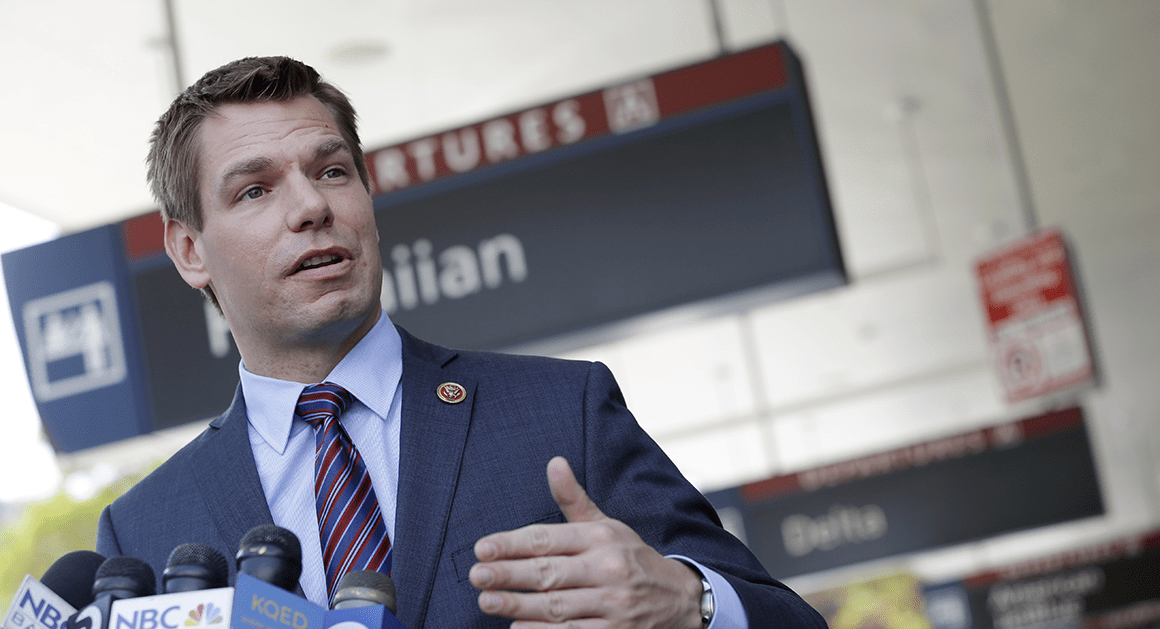Rep. Eric Swalwell took the stage on Jimmy Kimmel Live last night and stunned everyone with his announcement. He declared his candidacy for California governor in 2026 right there under the bright lights. The audience erupted in cheers as he promised to fight for families and keep national chaos at bay. This move thrusts him into one of the nation's most intense political showdowns. California voters face tough choices on housing costs, public safety, and economic growth. Swalwell's entry adds fresh energy to a race already buzzing with big names and bigger ambitions.

Swalwell’s serious gaze says it all—he’s entering a governor’s race where conviction matters, but financial muscle matters even more. As he looks toward California’s future, the stakes, and the spending, have never been higher.
Swalwell's Announcement Sparks a Fundraising Firestorm
Swalwell hit the ground running with a message that blends personal grit and sharp politics. He told the San Francisco Chronicle he aims to shield California from outside threats while building a bolder future. His words carry weight from years in Congress battling high-stakes issues like impeachment.
Now he turns that fire toward Sacramento. Donors from across the country perked up immediately. National networks see this as a chance to back a proven fundraiser against Republican influences. Swalwell's pitch resonates deeply in a state where everyday worries like rising rents and job security hit home hard. His story as the son of a cop adds a raw, relatable edge that could pull in suburban voters feeling overlooked.
The timing feels electric just days after billionaire Tom Steyer jumped in with his own massive self-funding pledge. Steyer's entry yesterday ramps up the pressure on everyone. Swalwell knows he must match that intensity to stand out. Early signs show small-dollar donations pouring in online, a sign his base mobilizes fast.
Yet the real test lies ahead in corralling the deep-pocket support needed to dominate airwaves. California politics demands not just passion but a war chest to match. Swalwell's national profile gives him an edge here. Still the emotional pull of his campaign tugs at voters tired of gridlock and eager for a fighter who gets their struggles.
The Real Payoff and Perks of the Governor's Chair
Voters often wonder if the grind of campaigning pays off in the end. The governor of California pulls in $242,295 annually as of the latest adjustments by the California Citizens Compensation Commission. That figure climbs with inflation to keep pace with the state's soaring living costs. Beyond the paycheck come perks that sweeten the deal significantly. The role includes a state-provided residence in Sacramento plus top-tier security details for the family. Travel budgets cover statewide jaunts and national trips to lure business. Most powerfully the position oversees a budget topping $300 billion each year. That control shapes policies on everything from tech innovation to wildfire response.
These benefits extend far beyond personal gain though. The governor wields influence that can launch national profiles or steer economic tides. Past holders like Jerry Brown turned the office into a platform for global climate talks. For Swalwell this means a shot at redefining his legacy while tackling California's unique challenges. Families grappling with utility bills or school funding see the role as a lifeline for real change. The emotional stake runs deep as communities pin hopes on leaders who deliver stability amid uncertainty. According to analysis reviewed by Finance Monthly the economic clout alone makes this job one of the most coveted in public service.

Pressed by reporters on the realities of the 2026 race, Swalwell leans into the moment—aware that every interview, every headline, and every donor impression counts in what is shaping up to be one of the most expensive gubernatorial contests in California history.
Inside the Money Machine Driving the 2026 Race
Past elections set a grim benchmark for what's coming. Gavin Newsom's 2018 victory demanded over $50 million in spending while his opponent poured in $30 million more. The 2021 recall effort shattered records at more than $300 million when counting all committees and PACs. Experts now forecast the 2026 contest could eclipse $350 million total as the field swells with heavy hitters. California's vast media markets drive these numbers sky-high. A single week's ad blitz in Los Angeles alone can swallow $2 million or more. Add San Francisco and San Diego and campaigns bleed cash just to stay visible.
Three dynamics fuel this escalation right now. First the race mirrors national divides with Swalwell's anti-Trump stance drawing coastal liberals like moths to flame. Second the state's size turns every outreach effort into a logistical beast demanding broad coverage. Third contenders like Steyer threaten to self-fund at presidential levels forcing others to scramble.
Political finance watchers note this pattern repeats in blue strongholds where visibility equals victory. Swalwell enters strong with Silicon Valley ties and impeachment-era donor lists. Katie Porter counters with unmatched grassroots hauls while Xavier Becerra leans on party insiders. Republicans like Chad Bianco tap conservative networks for their share. The vulnerability hits hardest for underdogs who fade without matching the spend. This isn't just politics. It's a high-stakes auction for the chance to steer a powerhouse economy.
The Deficit Dilemma: How the Next Governor Could Ease or Squeeze Your Budget
California stares down a fresh $18 billion budget shortfall for the coming year according to the nonpartisan Legislative Analyst's Office. This gap stems from surging spending on housing aid and education alongside dips in federal funds. Without swift action it could swell to $35 billion by 2028 threatening cuts to vital services like healthcare and schools. The incoming governor inherits this mess and holds the power to reshape it through tax tweaks or spending shifts. For everyday residents this means direct hits to wallets via potential fee hikes or program trims.
Think of it like balancing a family checkbook on steroids. The state collects revenue mainly from income and sales taxes but volatile tech booms make forecasts tricky. Gabe Petek California's legislative analyst put it bluntly in his latest report. He stressed that lawmakers must act decisively to avoid deeper holes that burden working families most. A real-world example plays out in last year's scramble where temporary tax boosts plugged gaps but left lingering doubts.
Historically states facing similar crunches saw recovery rates around 70 percent within two years when leaders prioritized growth sectors like green energy. Swalwell could champion incentives for small businesses to spark jobs and revenue. Or he might push progressive taxes on high earners to fund safety nets. Either path the choice ripples into your grocery bill or mortgage rate. This race isn't abstract. It decides if California thrives or tightens belts further amplifying the emotional urgency for voters seeking relief.
In wrapping up Swalwell's leap into this fray marks a pivotal moment. The 2026 governor's race blends raw ambition with fiscal reality in ways that touch every corner of the state. It promises drama money and maybe even solutions to long-festering woes. As ballots loom California stands at a crossroads. The winner won't just claim a title. They will guide one of the planet's top economies through turbulent times. Swalwell bets his vision and hustle can win over doubters and donors alike. Voters now hold the cards deciding if his fight becomes their future.
What Readers Want to Know: Key Questions on the 2026 Governor Race
Who Are the Front-Runners in Eric Swalwell's California Governor Challenge?
The field boasts heavyweights like Katie Porter with her sharp populist edge and Tom Steyer wielding billionaire resources. Early polls from Emerson College place Porter at 16 percent followed by Steve Hilton at 10 percent. Swalwell's late entry shakes things up leveraging his national fame for quick momentum.
Fundraising reports show Porter leading in small donations while Steyer eyes self-funding bursts. Bianco draws conservative support in rural areas. This top-two primary setup means Democrats must consolidate to avoid a split. Voters watch closely as debates clarify who best tackles affordability and safety amid economic pressures.
How Does Swalwell's Background Help Him in This Expensive Race?
Swalwell built a robust donor network during his impeachment role attracting over $10 million in cycles past. His East Bay roots and cop family ties ground him with working-class voters key in swing districts. Media savvy from Kimmel spots him ahead on visibility crucial in ad-heavy California. Challenges persist against Porter's online machine and Becerra's establishment backing. Still his anti-Trump fire could unlock East Coast cash flows. Success hinges on blending personal stories with policy wins to sustain enthusiasm through the grueling primary season.
What Economic Policies Might Swalwell Push as Governor?
Swalwell eyes modernizing infrastructure and boosting tech jobs to combat the housing crunch affecting millions. He advocates for public safety investments drawing from his law enforcement heritage to reassure suburbanites. On the deficit he favors targeted tax reforms on corporations over broad hikes preserving middle-class relief. Climate initiatives like expanded green energy credits aim to create jobs while cutting long-term costs. These stances position him as a pragmatic fighter but face scrutiny in a budget-strapped state. Implementation would demand bipartisan deals to deliver tangible wins for families feeling the pinch daily.














